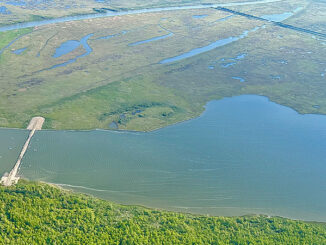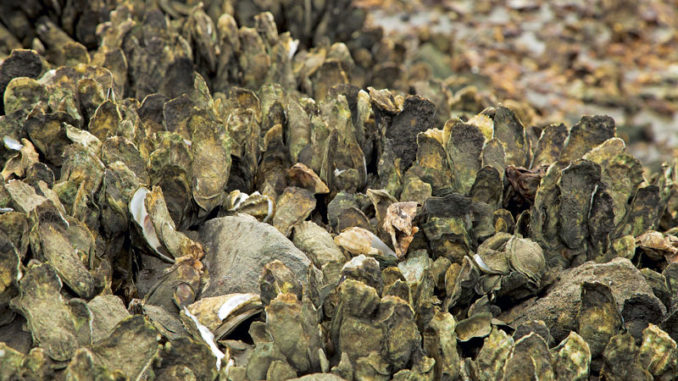
Healthy oyster beds offer a variety of action for saltwater anglers
As an angler and resident of a coastal state, you may enjoy eating oysters, but are they important to your fishing? Let’s talk about oysters and then you can decide.
A healthy commercial oyster bed is a thriving ecosystem supporting many trophic levels of organisms, including fish species like black drum, sheepshead, red drum and speckled trout. The key characteristic is a “healthy” oyster bed, which means it has a certain density of oysters, which Louisiana Wildlife and Fisheries defines as at least 20 adults per square meter.
Oysters also grow as reefs, on rocks protecting shorelines and on manmade structures such as pilings. If you fish the Long Rocks area of the MRGO (Mississippi River Gulf Outlet), you may occasionally see a large dark tail appear above the water next to the rocks. These belong to bull black drum that are feeding on oysters living on the shoreline rocks. Likewise, oysters are one reason there are so many sheepshead along the MRGO rocks.
Undoubtedly, oysters have been harvested in Louisiana since the earliest humans lived here, but commercial oyster production is a more recent activity. Unlike some other places on the Gulf Coast, our muddy bottom estuary supports fewer natural oyster reefs, but many oyster beds are created by the commercial fishing industry. The commercial industry has expanded the habitat for oysters across swaths of the Louisiana marsh where fewer oysters could grow without the commercial practices.
The method by which the industry has expanded the habitat is placing cultch on mud bottoms. Cultch is fragments of hard materials such as gravel, crushed concrete or recycled oyster shells and it is dumped from boats to created fields of oyster habitat. These fields of cultch are marked with white PVC pipes, and many anglers assume that within the boundary of all white poles lies a flourishing habitat where speckled trout congregate.
How true is that assumption? That question will be answered as we look inside the life of an oyster.
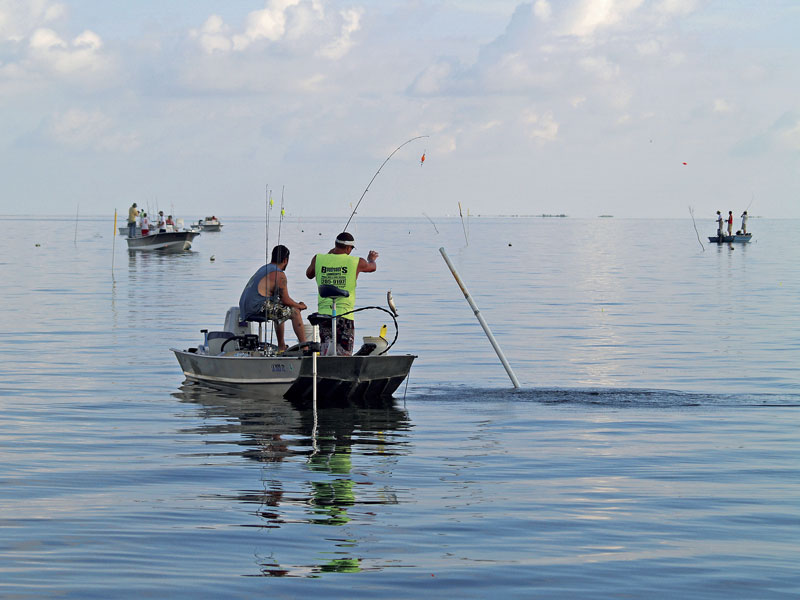
The life of an oyster
Oysters are a shellfish and a sessile organism. These two characteristics are useful to me as a speckled trout angler. First, as shellfish, they filter water to capture plankton for food, and that inadvertently removes suspended solids from the water. A single oyster can filter 50 gallons of water per day. I search for cleaner water when I am trout fishing, so oysters are my friends in seasons of high turbidity or after storms. The second thing I like about oysters is that, being a sessile organism, they don’t move, which reduces the time I have to spend searching for cleaner water.
Oysters can start spawning as young as one year old, but a three year old oyster is preferred for a “seed” oyster. The oyster spawn is similar in several ways to the speckled trout spawn. The eggs and sperm are released into the water where they mix to create fertilized eggs. These eggs develop into larva and float in the water currents. After two weeks, the larva develop a foot (the pediveliger stage) and then begin looking for a hard surface where they will attach themselves. This is why oystermen will hang mesh bags of shells or crushed concrete on a pole to see if an area has good oyster recruitment. If they find pediveliger or spat (the next phase of development) showing up in the bags, then they know this could be an area worth developing with cultch.
Like speckled trout, water salinity is critical to the oyster spawn and at least 10 ppt (parts per thousand) is required because the eggs and the next stage of larva need buoyancy. As speckled trout anglers, we are chasing the salinity gradient from May to September to find the schools, but oysters cannot move to the correct salinity to spawn. That is why there is opposition from the oyster industry towards the coastal restoration river water diversion projects. While adult oysters can live in a wide range of salinity, they will not spawn in low salinity water, nor would the eggs survive without the buoyancy higher salinity provides.
In the correct salinity, the larva float and grow as they move with the water currents until they find a hard surface to stick themselves onto. In Louisiana, that surface will often be a piece of cultch. Once attached, they never move again, at least until an oysterman takes them for a walk in the fields of cultch.
So, now we have come back to the question of whether we anglers should take an interest in oysters beyond their buttery, saltiness in our mouths. I think the answer is yes, and I would like to help you use knowledge about commercial oyster production to catch more speckled trout and other game fish.
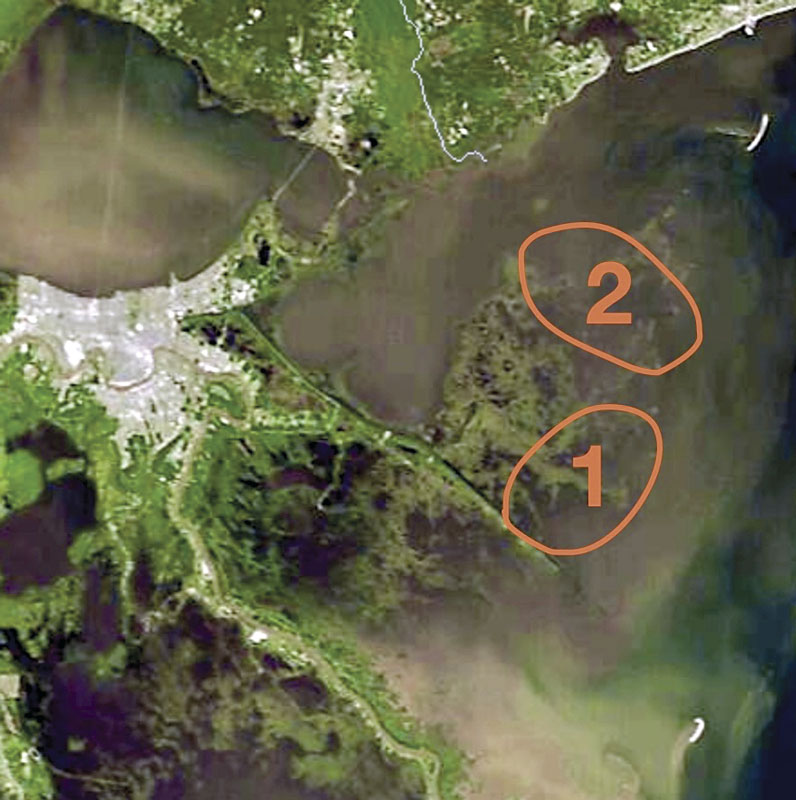
Where and when to fish oyster beds
I have caught some beautiful speckled trout around oyster reefs in the colder months, but my standard operating procedure is to fish on oyster beds in the summertime. There are some good reasons that summertime and oyster beds go together.
Summertime fishing is unique from the rest of the year due to the immense pressures put on trout because of their desire to reproduce. For starters, they are pushed into higher salinity water, which increases their susceptibility to predation and encourages them to school for protection. On top of an increased nutrient intake requirement driven by egg production, the high water temperature cranks up their metabolism requiring them to eat much more frequently. This means they need to stay close to large concentrations of bait, and they feed in shoals to increase their effectiveness. They are already bunching together to avoid predation and to spawn, so it is basically the equivalent of a four month long frat party. What better place is there to have a party than on a healthy oyster bed, which is already a habitat teaming with life?
There are many areas along the Louisiana coast with oyster beds, but I frequent the beds from the MRGO to Christmas Camp Lake and the beds in Three-Mile Pass, which is in the Biloxi Marsh.
How to find productive oyster beds
If you have fished oyster beds even a little bit, you know that plopping down in the middle of white poles is no assurance of fishing success. In fact, most of those white poles will bring you nothing but hardhead catfish.
First of all, many white poles are marking fields of mud and not fields of cultch. If you have stepped out of the boat in the Mississippi River estuary, you know the bottom is not very supportive for you or for cultch. Our many storms will also cover low lying oysters beds with sediment, which is why Wildlife and Fisheries and private lease holders must restore oyster beds periodically by dumping cultch. There are some natural oyster reefs in Louisiana and to survive they grow vertically to stay above the mud, which cannot happen on commercial beds where the oysters are harvested every few years.
To muddy the waters even more, an oysterman told me they sometimes move the white poles away from the oyster bed and into adjacent mud bottoms to confuse oyster thieves. So, white poles can mark anything from mud to thriving oyster communities and we need the tools to discover how to identify which ones are worth fishing.
If you fish oyster beds for trout in the summertime like I do, as a baseline you need to be sure you are fishing over beds that are in water with salinity around or above 15 ppt. That is quite easily done in the field with a simple hydrometer from PetSmart that costs $7.59. I have a $70.00 conductivity meter that is very accurate and correlates to salinity, but I have found that the $7.59 hydrometer is accurate enough and so much simpler to use that I never bother with the scientific instrument anymore.
You also need positive feedback that there is an elevated bed of oysters or cultch where you are planning to fish. That information can be gotten using imaging sonar or with the low tech and very accurate method of dragging a heavy lead-head across the bottom. If the signal coming back through the fishing line is crunchy and the hook is getting securely snagged, you can bet that is an area with live oysters or at least exposed cultch.
As with all trout fishing, water currents improve the bite, and so casting through a tide line that passes over oyster beds is always worth a shot.

I avoid fishing in areas that are being worked by the commercial oyster boats. Unless you can see them dumping cultch, they are harvesting the oysters. Harvesting leaves the water very muddy and the benthic ecosystem is disrupted by the harvesting tongs.
Finally, let’s not forget to look for the presence of bait, which should be the hallmark of an ecologically rich area. Visual signals are the single splash and flash of a pogie (menhaden), shrimp jumping out of the water or swimming near the surface, birds diving, and of course speckled trout feeding on the surface. You can also identify a productive area by the presence of feeding dolphins, but I would not recommend fishing where they are. Their presence really squashes the trout bite. Ironically, dolphins regularly use anglers to find the schools of trout on oyster beds. Last summer, they were using me so freely that I could only get about five minutes with a shoal of trout before they would motor in and blowup the party.
Big three
Summertime, live shrimp, and oyster beds are a threesome that often unites for a successful speckled trout trip and the feeding of many hardhead catfish. Since I only fish with artificial baits, my alternative to live shrimp is the popping cork and a 1/8-ounce jig with my favorite plastics. I have caught plenty of trout without the cork, but the cork rig is by far the most productive artificial bait presentation in this situation.
As you know, fishing under diving seagulls in the summer can wear your patience thin with undersized trout. In an attempt to catch larger fish under birds diving over oyster beds, I started experimenting with tight lining a ¼-ounce jig in a delayed hook set approach. I found that in many cases I can feel the size of the fish by the force of the strike. Therefore, if I only set the hook on the bigger strikes, I only catch the legal sized trout, if they are present. In my mental image, the jig falls through the upper part of the water column, where it gets smashed multiple times by undersized trout and spit out because I did not set the hook. As a result the jig falls through the small trout and gets picked up by a legal sized trout on which I set the hook. I am still trying to verify that this is largely repeatable, but I have had some success with this approach.
Of the hard baits, I have had the most enjoyment using topwater baits over oyster beds. As strange as that sounds, there are circumstances where you can have a rocking time on oyster beds with big, enraged trout trying to break the bait in half. Unfortunately, in my experience, those circumstances are limited in duration, such as when a cloud passes by. Still, I will keep a topwater bait tied onto a rod just for that special moment.
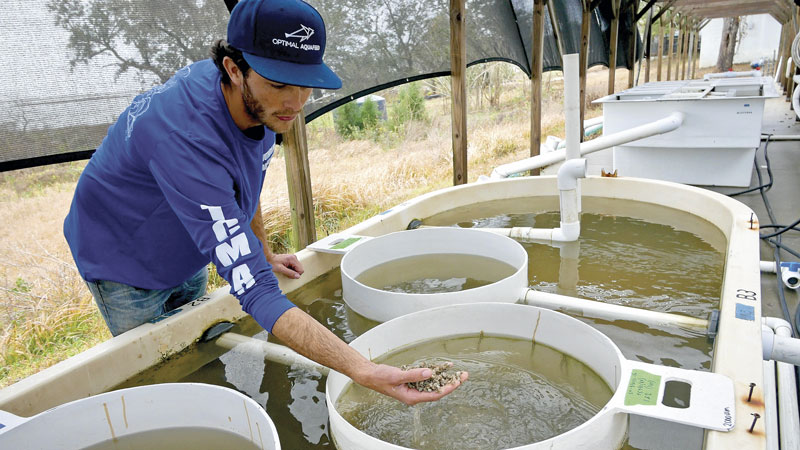
Helping oysters flourish
In 2020, the Louisiana Wildlife and Fisheries put out a plan called the Louisiana Oyster Management and Rehabilitation Strategic Plan. It calls for several exciting programs to increase the health of the oysters in Louisiana by restoring reefs, improving habitat, evaluating low salinity tolerant oysters, building hatcheries, and more. The areas in southeast Louisiana with proposed funding for bed restoration and bed planting with oyster spat is the Biloxi Marsh and Bay Eloi.
Also of particular interest in the plan are evaluations to repair the Bohemia Spillway Water Control Structure, which would result in the closing of the Mardi Gras Pass, and to open a waterway through the MRGO dam. Both of these actions would increase the salinity in affected areas, thus making conditions better for oysters. To be clear, the plan calls for hydrological evaluations and studies, so we should not expect any changes soon.
